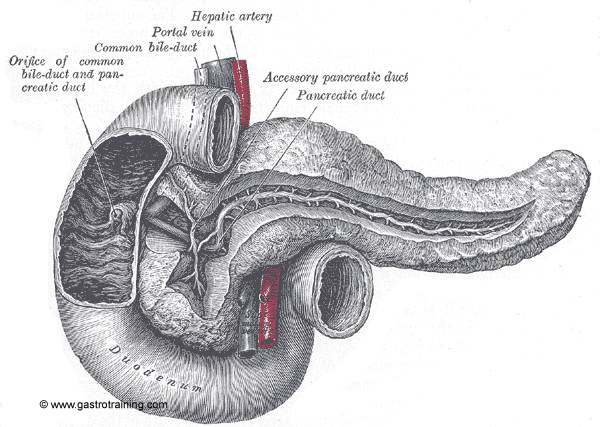Pancreas
Discuss the anatomy of pancreas?
- Herophilus, Greek surgeon first described pancreas. Wirsung discovered the pancreatic duct in 1642
- Location- 12-15 cms long located posterior to the stomach, across the posterior abdominal wall
- Function- both exocrine and endocrine gland. It secretes pancreatic juice that enters duodenum via pancreatic duct. It also secretes insulin and glucagon
- Parts- it has a head, neck, body and tail.
- Head- located with the curve of duodenum. It has a prolongation called the uncinate process
- Neck- is grooved posteriorly by the superior mesenteric vessels
- Body- it has three surfaces; anterior, posterior and inferior. The body of the pancreas is intimately related to the splenic vein.
- Tail-it passes between the two layers of the lienorenal ligament and its end contacts the hilum of the spleen
Discuss the ducts of the pancreas?
There are two ducts: main pancreatic duct (MPD) and an accessory one
MPD- it begins at the tail of the pancreas and runs (superficially beneath the posterior surface of pancreas) through the pancreas, receiving branches throughout its length. The MPD unites with the CBD to form the ampulla of Vater. There is a sphincter around the terminal part of MPD and around the ampulla of Vater (called sphincter of Oddi)
The accessory duct drains part of the head of the pancreas. Usually it is connected to the MPD, but in about 9% cases, it is a separate duct opening into the duodenum at the minor duodenal papilla (about 2 cms proximal to the ampulla of Vater).
Discuss the blood supply of pancreas?
Head-
Anterior and posterior superior pancreaticoduodenal artery (branches of gastroduodenal artery)
Anterior and posterior inferior pancreaticoduodenal artery (branches of superior mesenteric artery)
Body and Tail- splenic artery branches
Discuss the lymphatic drainage of pancreas?
- Pancreaticoduodenal nodes drain the head of the pancreas to the pyloric nodes (then to hepatic and coeliac nodes)
- Pancreaticosplenic nodes (lie along splenic artery on the superior border of pancreas) – drain the neck, body, and tail of the pancreas and are afferent to the coeliac nodes.
- Superior mesenteric nodes- also drain a portion of the pancreas.
Discuss the physiology of pancreas?
- It is both an exocrine and endocrine organ. Exocrine pancreas secretes digestive enzymes in the duodenum. Endocrine organ include islet of Langerhans the cells of which have four types of hormone secreting cells: A-cells secrete glucagon, B-cells secrete insulin, D-cells secrete somatostatin and F-cells secrete pancreatic polypeptide.
- Histology- 2 major components- acinar cells and ducts. These two constitute 80-90% of the pancreatic mass. 20-40 acinar cells coalesce into a unit called acinus. Acinar cells secrete the digestive enzymes. Ductal system; Acinus small intercalated ducts interlobular duct pancreatic duct
- Digestive juices;
- Pancreas secrete 500-800 mls of digestive juices every day
- Pancreatic juice contains amylase, lipase and proteases (trypsinogen, chymotrypsin, elastase, carboxypeptidase, and phospholipase) Amylase is the only pancreatic enzyme secreted in an active form. Lipases emulsify and hydrolyse lipids in the presence of bile salts. Proteases are secreted as proenzymes. The duodenal enzyme, enterokinase, converts trypsinogen to trypsin. Trypsin, in turn, activates chymotrypsin, elastase, carboxypeptidase, and phospholipase.
- Pancreatic juice also contains water and electrolytes (esp. bicarbonate) secreted by the centroacinar and intercalated duct cells
- Secretion of enzymes by pancreatic gland cells is stimulated by the hormone cholecystokinin which is released from the wall of the duodenum. In addition the hormone secretin, results in the pancreas making bicarbonate rich fluid. Secretin – released from the duodenal mucosa in response to a duodenal luminal pH < 3









